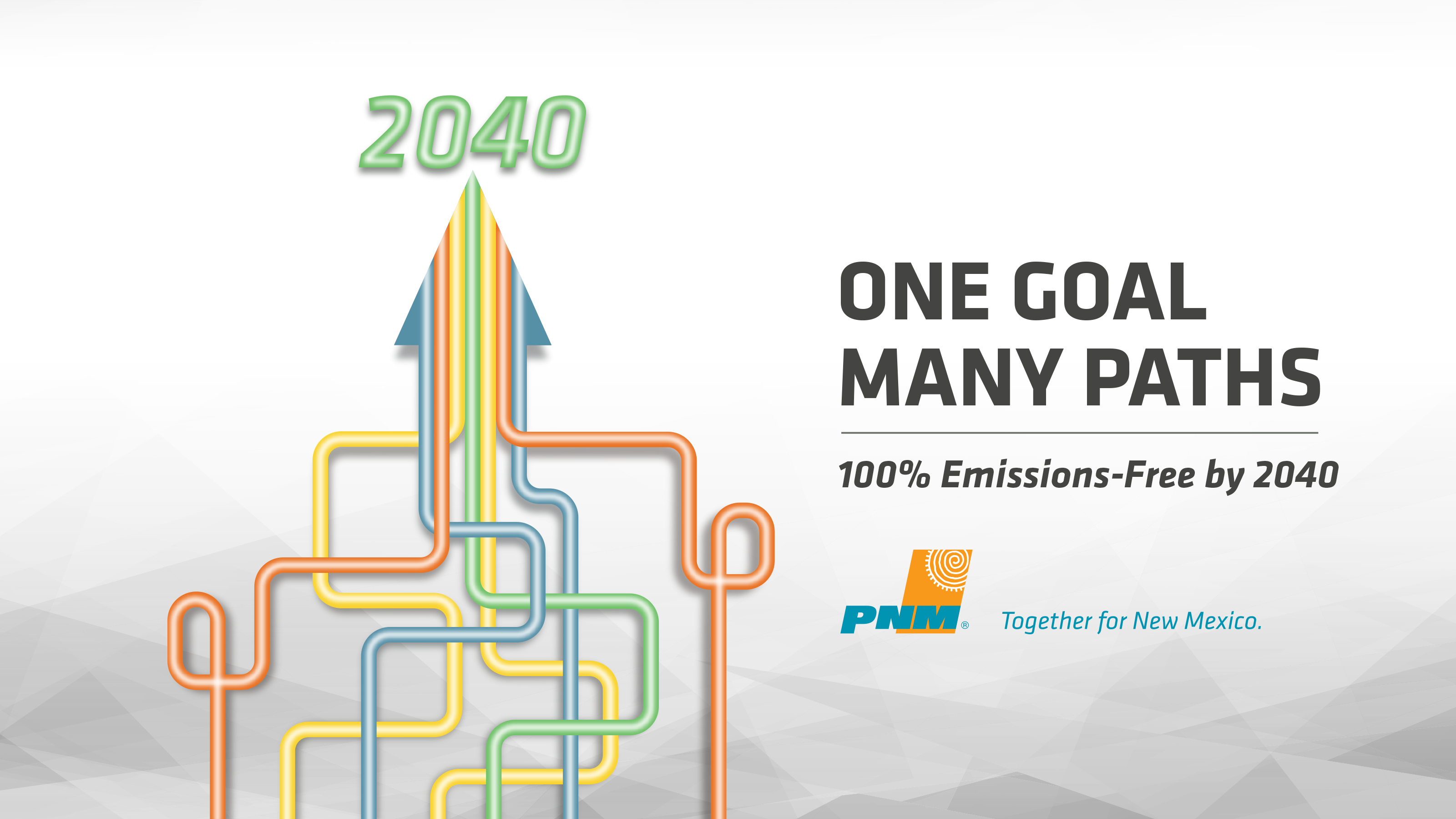Moving New Mexico Forward Together
Giving New Mexicans Unprecedented Opportunities and Transparency into the Paths to 100% Emissions-Free Energy by 2040

PNM will continue down the path of unprecedented collaboration, which aided in the passage of the Energy Transition Act. The San Juan Generating Station Replacement Power filing demonstrated our commitment to transparency and open communication with stakeholders and the New Mexico Public Regulation Commission (PRC). We conducted stakeholder conferences to provide direct communication with modelers and others in an open discussion format.
PNM clearly outlined multiple distinct pathways to replace energy as a result of the San Juan Generating Station shutdown. These plans gave customers and stakeholders continued transparency and the information they needed to form their own insights into options for where, and how, the energy needed to power their homes and businesses is generated and how much it costs.
PNM collaboratively identified and modeled several distinct paths. This not only illustrated the least cost plan, as mandated by law, but also considered alternatives that included options for geographic placement of renewable energy resources and choices between emissions-free technology and lower cost next generation natural gas. PNM wanted stakeholders to have more information and understanding as we meet the Renewable Portfolio Standard requirements and transition to 100% emissions-free energy.
PNM will continue this collaborative work with customers, environmental organizations, businesses, and other stakeholders to form a long-term plan for our future as part of our Integrated Resource Plan (IRP) (www.PNM.com/IRP).
PNM HAS A 100% POSITIVE ENERGY FUTURE FOR NEW MEXICO
How is it possible for PNM to turn most of New Mexico into a 100% emissions-free energy provider by 2040?
The key is “Transition” not “Additions.” The plan recognizes that developments in energy markets and technology now allow for a move away from fossil fuel without jeopardizing reliability or necessitating high costs.
The Energy Transition Act (ETA) is NOT the California model. New Mexico's ETA is intended to take a sensible path by transitioning existing energy resources to emissions-free resources in a controlled and cost-effective manner, instead of forcing unneeded additions of renewable resources into generation portfolios.
PNM was already positioned to be over 70% emissions-free by 2032 with the planned exits from San Juan and Four Corners power plants; with the current price of renewables, this energy transition can be completed in a cost-effective manner.
Completing an energy transition by replacing traditional resources with cleaner alternatives can lower existing resource costs, reduce fuel costs and in some cases may even result in lower customer bills.
What are recent developments for solar energy costs?
The National Renewable Energy Laboratory report illustrates the price of utility-scale solar decreasing by 80% from 2010 costs. PNM has experienced similar declines in available solar bids within New Mexico. This significant reduction in costs helps enable this transition to now occur at a reasonable cost.

Is wind power part of the answer?
The industry and PNM have seen similar price decreases for wind energy as well. As we all know New Mexico is well positioned with valuable wind energy that is the envy of many other states.
In our Renewable Portfolio Standard filing, PNM proposed an addition of 140 Mega Watts (MWs) of wind power. This is a first step in meeting the milestones in the Energy Transition Act. This addition is a direct result of the Energy Transition Act changes to the current Renewable Portfolio Standard requirements.
PNM anticipates this wind resource to be available to our customers at one of the lowest rates PNM has seen yet.
This fuel-free resource will help offset the current fuel costs from existing traditional resources and is anticipated to result in a neutral impact to customers’ overall bills while at the same time raising the percentage of renewables on the PNM system by about 4%.
What do we anticipate is the cost impact of the San Juan replacement to PNM customers?
With new tools in the Energy Transition Act (ETA) the replacement of San Juan can be more cost effective for PNM customers.
Customers will see securitization costs as a new line on their bill in the summer of 2022, as well as an offset that accounts for the reduction in existing resource costs and associated fuel costs.
Part of these savings result from a PNM agreement as part of the Energy Transition Act to forgo $109 million in profits it could have earned from having invested on these previously approved resources.
What are the longer range impacts we anticipate?
The industry has seen a significant decrease in the price for energy storage costs and PNM anticipates this trend to continue.
As its costs decline, energy storage will play a significant role in providing customers with a reliable supply of electricity and in operating a future electrical system that is 100% emissions free.
The 2020 Integrated Resource Plan (IRP) will give PNM and stakeholders even more insights moving forward and will outline an increasingly clean energy path that includes a 20-year planning period.
This stakeholder-driven process began in June 2019. More information can be found at .
Taking this path together gives New Mexicans the chance to shape the state’s energy future.
Individuals can participate in this process and stay connected with the 2020 IRP process by going to PNM.com/IRP.
How is this possible?
The PNM current electric system and generation portfolio are well positioned for the transition to meet the new Renewable Portfolio Standard and Energy Transition Act.
PNM has a strong backbone transmission grid. In the future, we will need additional transmission infrastructure to deliver energy, including wind sources. Achieving this goal will require collaboration in expanding our transmission capabilities.
New flexible generating resources are necessary to integrate renewable sources to the grid on a transitional basis. These units will be needed at times when renewables cannot match grid needs; as such, they are needed to allow renewables to replace the fossil fuel resources relied on today.
As newer energy storage and other advanced technologies continue to progress, PNM can phase out natural gas emissions entirely and complete the transition to 100% emissions-free generation.
Forward-Looking Statement Disclaimer: Information on this webpage may contain certain forward-looking statements within the meaning of the Private Securities Litigation Reform Act of 1995, including those that relate to future events or with respect to the expectations, projections, estimates, intentions, goals, targets, and strategies of Public Service Company of New Mexico (“PNM”) and its affiliates. Readers are cautioned that all forward-looking statements are based upon current expectations and estimates and that PNM and its affiliates assume no obligation to update this information, and that readers should consider the statements under the heading "Disclosure Regarding Forward Looking Statements" in the PNM periodic reports filed with the Securities and Exchange Commission.







